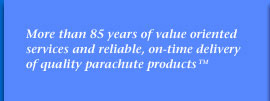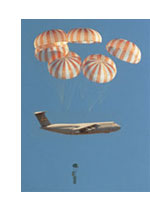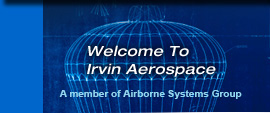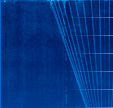

Press Releases

Orange
County Business Journal
Parachute Maker Eyes Military, NASA for Flight
By Brian Womack - 5/16/2005
Orange County Business Journal Staff
 Parachute maker Irvin Aerospace Inc. is looking for a lift from the recent
win of a key military contract and work on NASA ’s next generation
of spaceships.
Parachute maker Irvin Aerospace Inc. is looking for a lift from the recent
win of a key military contract and work on NASA ’s next generation
of spaceships.
Following the initial battles in Afghanistan during late 2001 and Iraq in early 2003, the Santa Ana company saw orders soar for parachutes that help everything from tanks to people to flares drift safely to earth.
Sales were more than $30 million in 2004—about double what they were three years earlier. It grew from 200 workers to about 350 employees during the period. But as U.S. military strategy shifted to the ground in the past year or so, Irvin saw its backlog of orders dry up. In the past six months the company has cut about 90 workers, and sales are expected to slip 10% this year.
Irvin’s experience is another chapter in what observers say is the boom and bust nature of the parachute industry. The latest downturn was no surprise to Irvin officials. They’re now aiming to grow without the catalyst of another conflict. Irvin’s been focused on improving via technology in the past several years, and it’s starting to pay off. Irvin recently won a $5.2 million contract for the first major design upgrade of military parachutes in decades. The win could help it land big contracts in the future.
Meanwhile, the company is looking to tap its technology advances for work with the National Aeronautics and Space Administration. Irvin President David Berry hopes to double sales in the next five years. He also expects to grow his staff to some 400 workers. "There are a lot of growth opportunities,” Berry said.
Irvin
is the 15th largest aerospace and defense contractor in OC, according
to last year’s Business Journal ranking. The company was bought
by British private equity firm Alchemy Partners in 2001. Alchemy moved
Irvin’s headquarters to Orange County from North Carolina in 2003.
Irvin operates under Alchemy’s Air-Sea Survival  Equipment
Ltd., which also is based in Britain. Berry said Alchemy typically takes
three to five years to turn around an investment before unloading it,
though he doesn’t expect the private equity firm to sell Irvin for
at least a couple of years. While Berry credits Alchemy’s backing
for its retooling, he also said a decision made 10 years ago to begin
using data analytics software to help design parachutes was critical.
Equipment
Ltd., which also is based in Britain. Berry said Alchemy typically takes
three to five years to turn around an investment before unloading it,
though he doesn’t expect the private equity firm to sell Irvin for
at least a couple of years. While Berry credits Alchemy’s backing
for its retooling, he also said a decision made 10 years ago to begin
using data analytics software to help design parachutes was critical.
The simulation software cut down on the need for real-world testing. In the past, parachute designers used a trial-and-error approach. That meant coming up with a new parachute, strapping it to a dummy, throwing it from a plane and recording the results. But with data analytics, many of those steps can be tested virtually, saving time and money. It also gives Irvin the opportunity to work with customers to figure out what kind of parachutes are needed before they ’re made. "They were definitely one of the people that were involved in that area early,” said Cliff Schmucker, president of the Parachute Industry Association. The technology first was used to help design a parachute in the late 1990s for firefighters who jump from planes to fight forest fires. That parachute became the prototype used to help win Irvin’s latest military contract. The new parachutes play into Secretary of Defense Donald Rumsfeld’s emphasis using Special Forces as a key element of a more nimble, fast-moving military.
Irvin’s parachutes are easier to control and maneuver than in the past. And they can stay in the air longer. Irvin’s $5.2 million contract is part of the military’s first phase of upgrades. Bigger contracts—possibly in the tens of millions—could come in the next two phases. Though the military prefers to divvy up contracts to different parachute makers, Irvin should get a big share of future awards, Berry said. Competitors include FXC Guardian Corp. in Santa Ana, among a handful of others. The contract win could help Irvine boost its share of work from other countries. Irvin hopes to win contracts in Asia and the Middle East.
The company wants to boost foreign sales to 20% to 25% of total revenue in the next several years. Foreign sales to NATO allies and Singapore, Taiwan, Japan and South Korea, among others, make up about 5% of its total today.
The company also has its eye on NASA. Berry said that NASA is looking to rework its space shuttle after recent disasters. The next generation of rocket ships will use high-end parachutes to gently float to earth. Just before touching down, giant balloons will inflate to cushion the landing. Berry said Irvin is working with NASA to help design the parachutes and balloons. It stands to get a big piece of the manufacturing contract when production begins sometime in the next decade.
| RETURN TO TOP | |
Home
| A Message From The President | About
Us
What's New | Products
| Engineering | Manufacturing
| Contact Us
Markets We Serve
2005 Irvin Aerospace


